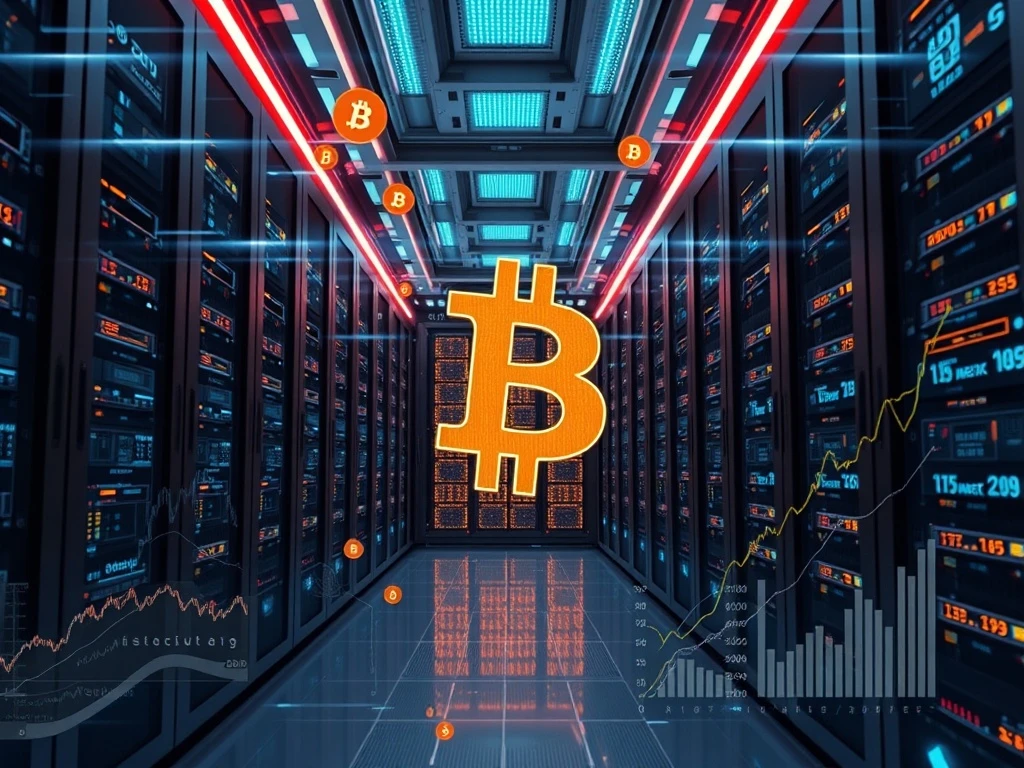Bitcoin Mining Industry Unveils $11B Convertible Debt Boom for AI Data Centers

The Bitcoin mining industry, traditionally focused on securing the digital gold network, is undergoing a profound transformation. Miners are now boldly pivoting towards an unexpected yet lucrative frontier: artificial intelligence. This strategic shift is fueling an unprecedented financial maneuver, as these companies secure a staggering $11 billion in convertible debt to fund their ambitious expansion into AI data centers. This significant investment not only highlights the industry’s adaptability but also signals a profound redefinition of its role within the broader technological and financial landscapes. The convergence of crypto and AI is creating new opportunities and challenges, making this a pivotal moment for both sectors.
Bitcoin Mining Industry Fuels AI Expansion with Record Debt
The Bitcoin mining industry is indeed experiencing a dramatic financial evolution, driven by both necessity and opportunity. Over the past year, miners have collectively raised an astonishing $11 billion through convertible debt instruments. This specific type of corporate debt offers investors the option to convert their holdings into equity shares of the company at a future date. This financing mechanism has become particularly prominent following the April 2024 Bitcoin halving, an event that fundamentally altered the economic landscape for miners by slashing the block reward by 50%.
According to data compiled by TheMinerMag, a total of 18 significant convertible bond deals have been completed since the halving. Furthermore, the average size of these bond issues has more than doubled compared to previous periods. Leading mining companies, including MARA, Cipher Mining, IREN, and TeraWulf, have each successfully raised $1 billion through single bond offerings. This demonstrates a robust market appetite for investing in the future prospects of these diversified crypto enterprises.
A remarkable aspect of some of these offerings is the inclusion of coupons as low as 0%. This unusual feature signals an extraordinary level of investor confidence. Investors are evidently willing to forgo immediate interest payments in exchange for the potential for substantial equity upside. They anticipate that the companies’ pivot into high-growth sectors like AI will significantly boost their stock value. This strategy offers a win-win scenario: miners gain access to crucial capital without immediate interest burdens, and investors position themselves for long-term growth.
The Strategic Pivot to AI Data Centers: A Synergistic Move
Miners are making a highly calculated and strategic move into AI data centers, primarily to address potential revenue shortfalls. The April 2024 halving significantly reduced the profitability of traditional Bitcoin mining. Consequently, diversification became not just an option but an essential strategy for sustained growth and long-term viability.
The synergy between Bitcoin mining operations and AI data centers is compelling. Bitcoin mining demands substantial infrastructure, including:
- Robust power supplies: High-performance computing requires immense energy.
- Advanced cooling systems: Heat generation from intensive processing is a major concern.
- Secure physical facilities: Protecting valuable hardware and data is paramount.
These infrastructural requirements are remarkably similar to those needed for operating high-performance AI computing facilities. By leveraging their existing assets and expertise, miners can transition their specialized hardware into powerful AI data processing units. This transition allows them to unlock entirely new revenue streams beyond just validating Bitcoin transactions. Essentially, they are repurposing their existing capital-intensive infrastructure to serve a burgeoning market. This strategic pivot ensures their long-term relevance and potential profitability in a rapidly evolving technological landscape. It also positions them at the forefront of two of the most significant technological advancements of our time: blockchain and artificial intelligence.
Understanding Convertible Debt in Crypto Financing
Convertible debt has quickly emerged as a pivotal tool for crypto financing within the Bitcoin mining sector. To clarify, a convertible bond is a type of corporate debt instrument that provides the bondholder with the option to convert the bond into a specified number of common stock shares of the issuing company. This conversion typically occurs at a predetermined price or ratio.
The recent surge in miner debt underscores the industry’s evolving financial landscape. According to a recent report from investment manager VanEck, miner debt has surged by an astounding 500% over the last year, reaching a total of $12.7 billion. Historically, Bitcoin miners primarily relied on equity markets to fund their substantial capital expenditures. These costs include the continuous acquisition and upgrading of specialized mining hardware, which often requires annual refreshes to maintain competitiveness.
VanEck analysts Nathan Frankovitz and Matthew Sigel highlighted the inherent challenge of these significant hardware costs, famously describing them as a “melting ice cube.” This vivid analogy illustrates how the value and efficiency of mining equipment rapidly depreciate, necessitating constant investment to remain viable. They emphasized the industry’s pressing need for innovative funding mechanisms beyond traditional equity raises.
The current preference for convertible debt reflects a strategic shift in financing strategies. It provides miners with immediate access to crucial capital, allowing them to fund their AI expansion and hardware upgrades. Simultaneously, it offers investors a unique proposition: the security of a debt instrument combined with the potential for equity appreciation if the company performs well. This hybrid financing model is particularly attractive in high-growth, high-risk sectors like crypto and AI, where traditional debt might be harder to secure or less appealing to investors seeking significant upside.
The Impact of Bitcoin Halving and Hashrate Dynamics
The Bitcoin halving impact in April 2024 was a watershed moment for the mining industry. This programmed event slashed the block reward for successfully mining a block by 50%, directly affecting miner profitability. For many, this reduction necessitated a fundamental re-evaluation of their business models and a push towards innovative approaches to revenue generation.
Furthermore, Bitcoin’s network hashrate, which represents the total amount of computing power dedicated to securing the network, continues its relentless upward trajectory. This rising hashrate creates a continuous arms race among miners. They must expend ever-greater computing power and energy resources to remain competitive and secure a share of the dwindling block rewards. Consequently, miners face immense pressure to continually upgrade their hardware and optimize their operations.
The challenging business model for miners extends beyond just the halving and hashrate. It also contends with a complex interplay of factors, including:
- Tokenomics: The supply and demand dynamics of Bitcoin itself.
- Trade policies: International regulations affecting hardware imports and energy.
- Supply chain issues: Disruptions in the availability of crucial mining equipment.
- Rising energy costs: A significant operational expense that can fluctuate dramatically.
In response to the energy demands of these intensive operations, US Energy Secretary Chris Wright proposed a regulatory change in October. This proposal to the Federal Energy Regulatory Commission (FERC) would allow data centers and miners to connect directly to energy grids. Such a move could offer mutual benefits. It would enable these energy-intensive applications to satisfy their substantial power needs. Simultaneously, they could act as “controllable load resources” for the energy grid. This means they could help balance and stabilize electrical infrastructure during times of peak demand by curtailing energy use. Conversely, they could consume excess energy during periods of low demand, thus optimizing grid efficiency.
Navigating Challenges and Future Prospects for Miners
The Bitcoin mining industry undoubtedly faces numerous ongoing challenges. Revenue pressures persist due to the halving, coupled with increasing operational costs associated with energy and hardware upgrades. However, the industry’s aggressive pivot to AI data centers represents a highly proactive and strategic response. This shift signifies a commitment to adapting business models to ensure future growth and resilience.
This adaptation involves substantial investment in new technologies and infrastructure, as evidenced by the $11 billion in convertible debt raised. The industry’s ability to secure such significant financing underscores a growing investor confidence in this transformation. Investors are clearly betting on the long-term potential of miners to successfully diversify their revenue streams.
By strategically moving into AI, miners aim to mitigate several key risks:
- Volatility of Bitcoin prices: Reducing reliance solely on block rewards.
- Escalating hashrate competition: Finding alternative uses for their computing power.
- Energy cost fluctuations: Potentially integrating more directly with energy grids for stability.
This strategic evolution could fundamentally redefine the role of Bitcoin miners within the broader digital economy. They are moving beyond merely securing the Bitcoin network and processing transactions. Instead, they are positioning themselves as critical infrastructure providers for the burgeoning artificial intelligence sector. This transformation suggests a future where Bitcoin miners are not just digital gold producers but also essential enablers of the next generation of computing power, thereby securing their place at the forefront of technological innovation.










